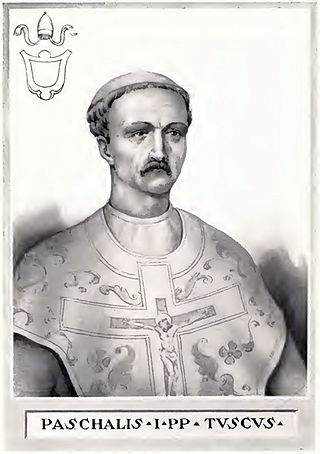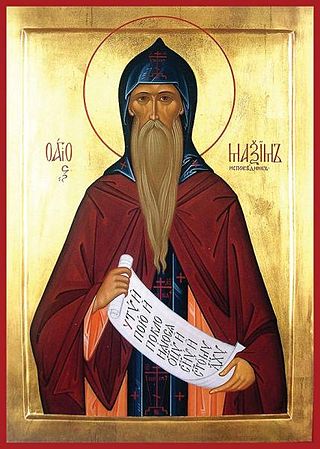The 810s decade ran from January 1, 810, to December 31, 819.

Year 817 (DCCCXVII) was a common year starting on Thursday of the Julian calendar.

Year 662 (DCLXII) was a common year starting on Saturday of the Julian calendar. The denomination 662 for this year has been used since the early medieval period, when the Anno Domini calendar era became the prevalent method in Europe for naming years.

Pepin II, commonly known as Pepin of Herstal, was a Frankish statesman and military leader who de facto ruled Francia as the Mayor of the Palace from 680 until his death. He took the title Duke and Prince of the Franks upon his conquest of all the Frankish realms.

Neustria was the western part of the Kingdom of the Franks during the early middle ages, in contrast to the eastern Frankish kingdom, Austrasia. It initially included land between the Loire and the Silva Carbonaria, in the north of present-day France, with Paris, Orléans, Tours, Soissons as its main cities. The population was therefore originally largely Romanised.

The Carolingian dynasty was a Frankish noble family named after Charlemagne, grandson of mayor Charles Martel and a descendant of the Arnulfing and Pippinid clans of the 7th century AD. The dynasty consolidated its power in the 8th century, eventually making the offices of mayor of the palace and dux et princeps Francorum hereditary, and becoming the de facto rulers of the Franks as the real powers behind the Merovingian throne. In 751 the Merovingian dynasty which had ruled the Germanic Franks was overthrown with the consent of the Papacy and the aristocracy, and Pepin the Short, son of Martel, was crowned King of the Franks. The Carolingian dynasty reached its peak in 800 with the crowning of Charlemagne as the first Emperor of the Romans in the West in over three centuries. His death in 814 began an extended period of fragmentation of the Carolingian Empire and decline that would eventually lead to the evolution of the Kingdom of France and the Holy Roman Empire.

Dagobert II was a Merovingian king of the Franks, ruling in Austrasia from 675 or 676 until his death. He is one of the more obscure Merovingians. He has been considered a martyr since at least the ninth century.

The Duchy of Benevento was the southernmost Lombard duchy in the Italian Peninsula that was centred on Benevento, a city in Southern Italy. Lombard dukes ruled Benevento from 571 to 1077, when it was conquered by the Normans for four years before it was given to the Pope. Being cut off from the rest of the Lombard possessions by the papal Duchy of Rome, Benevento was practically independent from the start. Only during the reigns of Grimoald and the kings from Liutprand on was the duchy closely tied to the Kingdom of the Lombards. After the fall of the kingdom in 774, the duchy became the sole Lombard territory which continued to exist as a rump state, maintaining its de facto independence for nearly 300 years, although it was divided after 849. Benevento dwindled in size in the early 11th century, and was completely captured by the Norman Robert Guiscard in 1053.
Grimoald, Grimald, Grimoart, Grimwald, Grimuald, or Grimbald is a Germanic personal name.

Perctarit was king of the Lombards from 661 to 662 the first time and later from 671 to 688.
Grimoald or Grimwald (†671) was a 7th-century King of Italy, ruling as Duke of Benevento from 647 to 662, and then as King of the Lombards from 662 until his death in 671.
Romuald I, duke of Benevento (662–687) was the son of Grimoald, king of the Lombards. When his father usurped the throne in 662, he left Benevento under Romuald and sent the deposed king Perctarit's wife, Rodelinde, and son, Cunincpert, into exile at the Romuald's court in Benevento.

Arechis II was a Duke of Benevento, in Southern Italy. He sought to expand the Beneventos' influence into areas of Italy that were still under Byzantine control, but he also had to defend against Charlemagne, who had conquered northern Italy.

Grimoald III was the Lombard Prince of Benevento from 788 until his own death. He was the second son of Arechis II and Adelperga. In 787, he and his elder brother Romoald were sent as hostages to Charlemagne who had descended the Italian peninsula as far as Salerno to receive the submission of Benevento. In return for peace, Arechis recognised Charlemagne's suzerainty and handed Grimoald over as a hostage.

Sico was the Lombard Prince of Benevento from the 817 to his own death.
Tassilo II was a ruler in southern Germany.
Grimoald II was the duke of Benevento from 687 to his death. He was the son and successor of Romuald I of Benevento. He was possibly under the regency of his mother, Theodrada, daughter of Lupus of Friuli. His reign of three years was uneventful: Paul the Deacon records nothing but his marriage and death. He is said to have been an opponent of the crown. He was succeeded by his brother Gisulf. He was married to Wigilinda, daughter of King Perctarit.
Gisulf I was the duke of Benevento from 689, when his brother Grimoald II died. His father was Romuald I. His mother was Theodrada, daughter of Duke Lupus of Friuli, and she exercised the regency for him for the first years of his reign.

Adelperga was a Lombard noblewoman, Duchess of Benevento by marriage to Arechis II of Benevento. She acted as regent of Benevento for her son Grimoald in 787-788. She was the third of four daughters of Desiderius, King of the Lombards, and his wife Ansa. Her elder sister Desiderata was a wife of Charlemagne.












